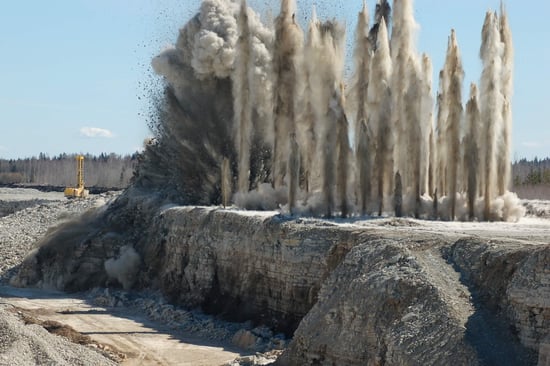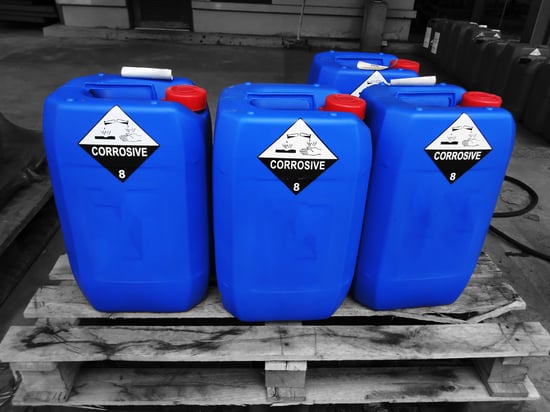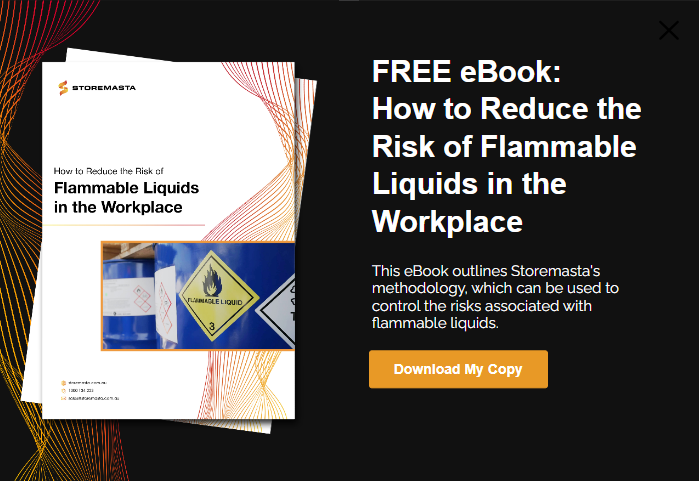If your organisation works with dangerous goods, the compliance of your operations is vital to the safety of your staff, property, the environment and the wider community. There are 9 classes of dangerous goods as outlined in the Australian Dangerous Goods Code. Dangerous goods are classed according to their physical and chemical properties — and the risks that they present. Classes range from DG Class 1 Explosives to Class 9 Miscellaneous Dangerous Substances and Articles.
DG Classes
The Australian Dangerous Goods Code states that:
“Substances (including mixtures and solutions) and articles subject to this code are assigned to one of nine classes according to the hazard or the most predominant of the hazards they present”.
Some of these dangerous goods classes (DG Classes) are sub-divided into specific divisions. Read on to learn more about the classes and divisions of dangerous goods in Australia.
Classes & Divisions Of Dangerous Goods
Class 1: Explosives
- Division 1.1: substances and articles which have a mass explosion hazard.
- Division 1.2: Substances and articles which have a projection hazard but not a mass explosion hazard
- Division 1.3: Substances and articles which have a fire hazard and either a minor blast hazard or a minor projection hazard or both, but not a mass explosion hazard
- Division 1.4: Substances and articles which present no significant hazard
- Division 1.5: Very insensitive substances which have a mass explosion hazard
- Division 1.6: Extremely insensitive articles which do not have a mass explosion hazard
Class 2: Gases
- Division 2.1: Flammable gases
- Division 2.2: Non-flammable, non-toxic gases
- Division 2.3: Toxic gases
Class 3: Flammable Liquids
There are no sub-divisions for Class 3 Flammable Liquids.
Class 4: Flammable Solids; Substances Liable To Spontaneous Combustion; Substances Which, On Contact With Water, Emit flammable Gases
- Division 4.1: Flammable solids, self-reactive substances and solid desensitised explosives
- Division 4.2: Substances liable to spontaneous combustion
- Division 4.3: Substances which in contact with water emit flammable gases
Class 5: Oxidizing Substances and Organic Peroxides
- Division 5.1: Oxidizing substances
- Division 5.2: Organic peroxides
Class 6: Toxic and Infectious Substances
- Division 6.1: Toxic substances
- Division 6.2: Infectious substances
Class 7: Radioactive Material
There are no sub-divisions for Class 7 Radioactive Material.
Class 8: Corrosive Substances
There are no sub-divisions for Class 8 Corrosive Substances.
Class 9: Miscellaneous Dangerous Substances and Articles
There are no sub-divisions for Class 9 Miscellaneous Dangerous Goods.
To better understand the class or division of your workplace’s hazardous substances and the risks they pose, we’ll now take a deeper dive into each class. Here, we detail the definition of each class of dangerous goods as per the relevant Australian standard:
Access your FREE Dangerous Goods Segregation Chart
Defining Each Dangerous Goods Class
DG Class 1: Explosives
As stated in section 2.1.1.1 of the Australian Dangerous Goods Code, Class 1 Explosives can be defined as:
(a) Explosive substances (a substance which is not itself an explosive but which can form an explosive atmosphere of gas, vapour or dust is not included in Class 1), except those that are too dangerous to transport or those where the predominant hazard is appropriate to another class; and
(b) Explosive articles, except devices containing explosive substances in such quantity or of such a character that their inadvertent or accidental ignition or initiation during transport will not cause any effect external to the device either by projection, fire, smoke, heat or loud noise; and
(c) substances and articles not mentioned under (a) and (b) which are manufactured with a view to producing a practical, explosive or pyrotechnic effect.”

Class 1 Explosives include substances and articles that explode or produce a pyrotechnic effect.
DG Class 2: Gases
According to section 2.2.1.1 of the Australian dangerous goods code, a gas is a substance which:
At 50 °C has a vapour pressure greater than 300 kPa; or is completely gaseous at 20 °C at a standard pressure of 101.3 kPa.
(a) Division 2.1 Flammable gases - Gases which at 20 °C and a standard pressure of 101.3 kPa: (i) are ignitable when in a mixture of 13 per cent or less by volume with air; or (ii) have a flammable range with air of at least 12 percentage points regardless of the lower flammable limit.
(b) Division 2.2 Non-flammable, non-toxic gases - Gases which: (i) are asphyxiant – gases which dilute or replace the oxygen normally in the atmosphere; or (ii) are oxidizing – gases which may, generally by providing oxygen, cause or contribute to the combustion of other material more than air does; or (iii) do not come under the other divisions;
(c) Division 2.3 Toxic gases - Gases which: (i) are known to be so toxic or corrosive to humans as to pose a hazard to health; or (ii) are presumed to be toxic or corrosive to humans because they have an LC50 value (as defined in 2.6.2.1) equal to or less than 5,000 ml/m3 (ppm).
DG Class 3: Flammable Liquids
Flammable liquids are substances that will burn in the presents of an ignition source. They are used to power commonly used equipment such as vehicles, generators, outdoor power equipment and more.
The Australian Dangerous Goods Code defines Class 3 Flammable Liquids as;
Flammable liquids are liquids, or mixtures of liquids, or liquids containing solids in solution or suspension (for example, paints, varnishes, lacquers, etc., but not including substances otherwise classified on account of their dangerous characteristics) which give off a flammable vapour at temperatures of not more than 60 °C, closed-cup test, or not more than 65.6 °C, open-cup test, normally referred to as the flash point. This class also includes:
(a) liquids offered for transport at temperatures at or above their flash point; and
(b) substances that are transported or offered for transport at elevated temperatures in a liquid state and which give off a flammable vapour at a temperature at or below the maximum transport temperature.
When working with flammable liquids, it is important to note that the flash point of a substance may vary in the presence of any impurity.
Flammable liquids must be handled and stored in a way to reduce the risk of fire and explosion.
DG Class 4: Flammable Solids
Flammable solids are substances liable to spontaneous combustion and/or substances which, in contact with water, emit flammable gases. When flammable solids combust, they often emit toxic gases.
Class 4 dangerous goods are divided into three divisions as follows:
(a)Division 4.1 Flammable solids are solids which, under conditions encountered in transport, are readily combustible or may cause or contribute to fire through friction; self-reactive substances which are liable to undergo a strongly exothermic reaction; solid desensitized explosives which may explode if not diluted sufficiently;
(b) Division 4.2 Substances liable to spontaneous combustion are substances which are liable to spontaneous heating under normal conditions encountered in transport, or to heating up in contact with air, and being then liable to catch fire;
(c) Division 4.3 Substances which in contact with water emit flammable gases Substances which, by interaction with water, are liable to become spontaneously flammable or to give off flammable gases in dangerous quantities.
DG Class 5: Oxidizing Substances and Organic Peroxides
The Australian Dangerous Goods Code defines Class 5 dangerous goods as:
(a) Division 5.1 Oxidizing substances are substances which, while in themselves not necessarily combustible, may, generally by yielding oxygen, cause, or contribute to, the combustion of other material. Such substances may be contained in an article;
(b) Division 5.2 Organic peroxides Organic substances which contain the bivalent -0-0- structure and may be considered derivatives of hydrogen peroxide, where one or both of the hydrogen atoms have been replaced by organic radicals. Organic peroxides are thermally unstable substances, which may undergo exothermic self-accelerating decomposition. In addition, they may have one or more of the following properties: (i) be liable to explosive decomposition; (ii) burn rapidly; (iii) be sensitive to impact or friction; (iv) react dangerously with other substances; (v) cause damage to the eyes.
DG Class 6: Toxic and Infectious Substances
Class 6 is divided into two divisions. These definitions for each sub-division according to the ADG code are outlined below:
(a) Division 6.1 Toxic substances These are substances liable either to cause death or serious injury or to harm human health if swallowed or inhaled or by skin contact;
(b) Division 6.2 Infectious substances These are substances known or reasonably expected to contain pathogens. Pathogens are defined as micro-organisms (including bacteria, viruses, rickettsiae, parasites, fungi) and other agents such as prions, which can cause disease in humans or animals.
DG Class 7: Radioactive Material
According to section 2.7.1.1 of the ADG code, radioactive materials are defined as:
Any material containing radionuclides where both the activity concentration and the total activity in the consignment exceed the values specified in the relevant Australian standard, (AUST ST. FOR CLASS 7)
For more detailed information about radioactive materials, check with your supplier, the relevant MSDS, or a professional Dangerous Goods Consultant.
DG Class 8: Corrosive Substances
The Australian Dangerous Goods Code defines corrosive substances as:
Class 8 substances (corrosive substances) are substances which, by chemical action, will cause severe damage when in contact with living tissue, or, in the case of leakage, will materially damage, or even destroy, other goods, substances, or objects.

Corrosive substances can harm people, property and the environment
DG Class 9: Miscellaneous Dangerous Substances and Articles
According to the Australian Dangerous Goods Code, Class 9 dangerous goods are defined as:
Class 9 substances and articles (miscellaneous dangerous substances and articles) are substances and articles which, during transport present a danger not covered by other classes.
This includes:
(a) environmentally hazardous substances which are not covered by other classes;
(b) elevated temperature substances (i.e. substances that are transported or offered for transport at temperatures equal to or exceeding 100 °C in a liquid state or at temperatures equal or exceeding 240 °C in a solid state); (c) GMMOs or GMOs which do not meet the definition of infectious substances (see Section 2.6.3) but which are capable of altering animals, plants or microbiological substances in a way not normally the result of natural reproduction.
Storing all DG Classes Safely
In this blog, we’ve detailed each dangerous goods class and their sub-divisions. As each class of dangerous goods have different chemical and physical properties, you must ensure that each class is stored and managed in a safe and compliant manner.
An Australian Standard applies to each dangerous goods class and this details the requirements for the storage and handling of the substance. For example, the Australian Standard for Class 3: Flammable Liquids is AS 1940. To learn more about the safe storage and handling of flammable liquids, simply click on the image below to access our FREE eBook. This helpful and easy-to-understand guide outlines how your organisation can reduce the risk of flammable liquids in the workplace.
Joining the team as a Dangerous Goods Storage Consultant, Melissa Hampton became Storemasta's Marketing Manager in late 2021. With extensive knowledge and experience in chemical compliance, Melissa is responsible for leading the Marketing team and helping shape their marketing strategy. In her spare time, you can find Melissa hiking, swimming and enjoying the great outdoors in beautiful north-west Tasmania.

